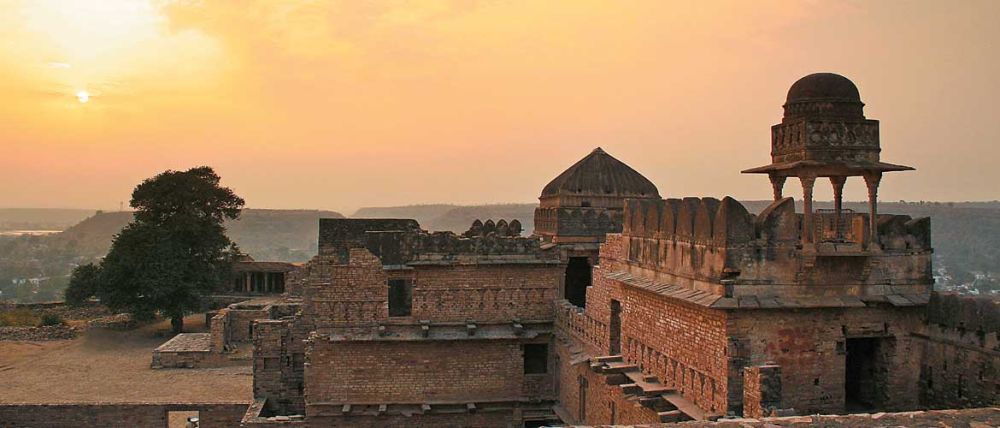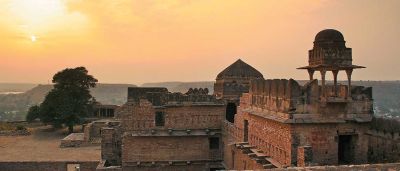

The Chanderi Fort, perched atop a hill, offers a panoramic view of the town and its surroundings. This fort has been a witness to the town's long history and has undergone various transformations under different rulers. Visiting the fort, you will be able to see old structures, intricate carvings, and remnants of the battlements. It is an enlightening experience for history buffs and a chance to appreciate ancient architecture. As you explore the fort, you'll come across historical anecdotes and stories that bring the bygone era to life. Make sure to wear comfortable shoes as you'll be doing a fair bit of walking and climbing to reach to the fort.
The Badal Mahal Darwaza is an impressive gate that once served as an entrance to the now-ruined Badal Mahal. Standing tall as a lone sentinel, this architectural marvel reflects the fusion of Mughal and Afghan styles. It's located near Kati Ghati and provides a great photo opportunity against the backdrop of Chanderi's natural landscapes. While there's not much walking required to reach this historic gateway, do spend some time soaking in its grandeur and picturing the royal processions that might have passed through its portals centuries ago.
Chanderi Museum, also known as the Chanderi Archaeological Museum, is a treasure trove of ancient artefacts, sculptures, and remnants of local heritage. The museum showcases the town’s rich cultural history through its impressive collection. The artefacts displayed span across various historical periods, providing a glimpse into the life and times of the people who lived in the region. From terracotta items to stone sculptures, and a variety of other antiquities, the museum serves as a fascinating educational experience for visitors of all ages.
Chanderi is renowned for its exquisite handwoven Chanderi sarees. An activity not to be missed is a visit to a local weaver's home or workshop where one can witness the intricate process of weaving these fine textiles. Observe the skilled craftsmen at work, as they create delicate patterns and motifs on the loom. This is a chance to understand the time and effort that goes into making each saree, and why Chanderi sarees are celebrated for their lightweight, sheer quality and luxurious feel. It's also a unique opportunity for visitors to purchase sarees directly from the artisans, ensuring an authentic and valuable addition to one’s wardrobe.
Koshak Mahal is a striking historical palace that symbolizes the town's long-standing architectural significance. Built by the Sultan of Malwa, Mahmud Khilji, in the 15th century, the structure was intended to be seven-storied, but only three were completed. Visitors to Koshak Mahal are entranced by its unique cross-shaped design and massive stone walls. The grandeur of its ruins hints at the past splendour and might, offering a fascinating peek into the history of Chanderi while also providing ample opportunities for enthusiasts to capture the beauty in photographs. The serene surroundings add to its charm, making it a memorable spot for history lovers.
Parameshwar Tal is a serene lake located near the Chanderi fort and is surrounded by temples and cenotaphs, which reflect the town’s spiritual history. This tranquil spot is perfect for those looking to experience peace and contemplation. Visitors can take a leisurely stroll around the lake, observe the local flora and fauna, and enjoy moments of reflection by the waterside. The setting is also idyllic for picnics and family outings. The nearby temples create an air of devotion and the echoing sounds of temple bells further enhance the spiritual atmosphere.
The Jama Masjid of Chanderi is an example of Sultanate-era architecture with its impressive gateways, domes, and prayer hall. Having stood the test of time, this mosque remains a place of worship as well as a monument of historical significance. Tourists visiting the mosque can take in the serene and calm atmosphere while marveling at the intricacy of the stonework. Respect for the mosque's cultural and religious significance, as well as for the worshippers, is expected when visiting. This visit can provide insight into the spiritual and communal life of Chanderi as well as offer a tranquil respite from the busy travel schedule.
Battisi Bai ka Madrasa stands as a historical educational institution in Chanderi. This 15th-century madrasa showcases a blend of Islamic and Hindu architectural styles, reflecting the secular fabric of the region’s past. The name 'Battisi' translates to 'thirty-two' in Hindi, indicating a legend that the madrasa had thirty-two steps leading to its entrance. Although it now lies in ruins, the remnants of the madrasa’s walls, arches, and hallways still echo the scholarly pursuits once undertaken here. A walk through the ruins is an opportunity to appreciate the architectural splendour and imagine the vibrant academic discussions of the time.
For adventure seekers, a trek to Thubonji, a hill near Chanderi, is an exhilarating activity. This trek offers stunning landscapes and a chance to connect with nature. It's a relatively moderate hike, suitable for most fitness levels, that leads to a Buddhist complex consisting of stupas and viharas. The structures, now largely in ruins, whisper tales of a time when Buddhism thrived in the region. Hikers can relish the fresh air and quietude while exploring the remnants of this ancient site. The ascent rewards trekkers with striking views of the surrounding hillocks and plains, which are particularly breathtaking during sunrise or sunset.
Raja Rani Mahal, located in the heart of Chanderi, is another historic site not to be missed. Although much of it is in a state of decay, the mahal exudes an antique allure. Historians and architecture enthusiasts will enjoy delving into the bygone era that this palace evokes. With its array of arches, chambers, and domes, Raja Rani Mahal stands as a testament to the opulence and might of its former inhabitants. Visitors can walk among these ancient ruins and let their imagination reconstruct the life and vibrancy of the times when the palace was in its full glory. It's a humble yet poignant reminder of Chanderi's significant place in the region's historical tapestry.
